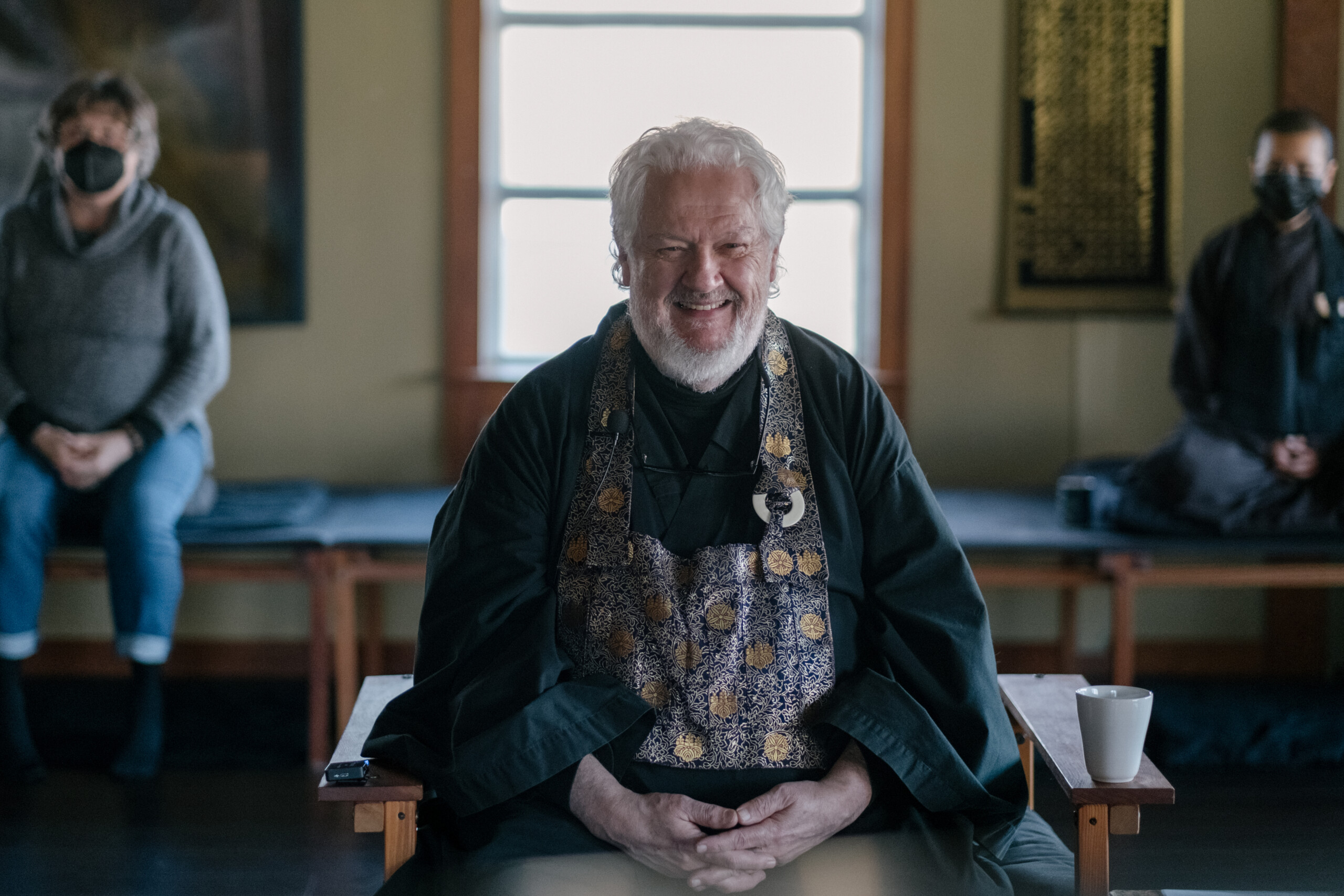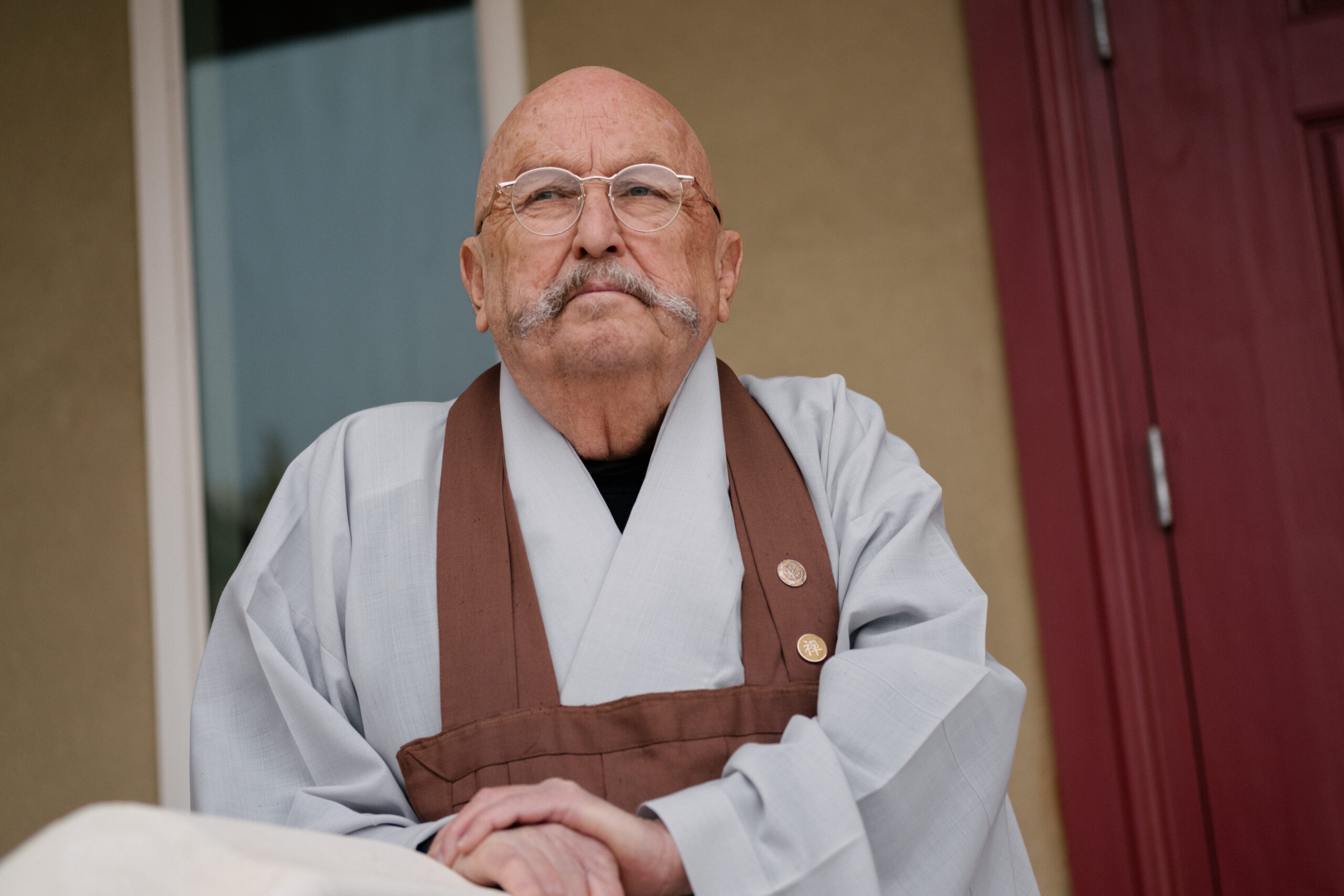Sensei Michael
And I was known for talking people down from bad trips and things of that nature. And he said, Oh, I don’t do that anymore. I just do Zen. Okay, well, that’s interesting. What’s that all about? And so I said, Well, I’m going this weekend. Why don’t you come with me? So that weekend I went with him to the temple on Halsted Street near Fullerton, on the North side of Chicago. I met Matsuoka Roshi, who became my teacher, so I sort of backed into that. Like everything else, I think I’d read maybe a book on Zen or to not not much.
Zen Master Ji Haeng
In the narrative of Zen Master Ji Haeng, the journey unfolds from the bustling stages of the music world to the tranquil realms of Zen practice. From his beginnings as a skilled musician, sharing the spotlight with icons like Frank Sinatra and Aretha Franklin, to his eventual immersion in the serene landscape of Zen, the story is one of profound transformation.
Ani Palmo
Ani Palmo, the director and resident teacher of Song San Gampo Buddhist Center in Lakewood, Ohio, shares her spiritual journey from a Catholic upbringing to discovering Tibetan Buddhism. Growing up in Garfield Heights, a suburb of Cleveland, Ani Palmo navigated her Catholic education with a sense of dissatisfaction, grappling with the teachings and treatment of women within the faith. Her exploration led her through various spiritual traditions, including New Age practices and Zen Buddhism in Japan, but she found them lacking in depth and spiritual fulfillment. It was during a retreat in Southern Thailand that she encountered Theravada Buddhism, which resonated deeply with her, offering a methodical approach to developing inner qualities.
Lama Thupten Rinpoche
Lama Thupten was always drawn to meditative practices, even before they were formally defined as such. He lived in many places throughout his life, but one of the most significant was Selma, Alabama. Thupten witnessed the brutality of racism firsthand, but he also found solace in nature and solitude. Even as a child, he spent a lot of time alone, observing the world around him.
Lisa
Lisa, currently residing in Nashville, Tennessee, originated from Florida and spent part of her youth in Atlanta before settling in Nashville. Discovering Buddhism at the age of 17 during a high school elective on Zen Buddhism, Lisa found solace in the teachings of impermanence, especially during a challenging period when she lost both parents at the age of 16.
Pema
Pema resides in Madison, Wisconsin, and is an integral part of Joyful Path Meditation and Healing Center, affiliated with the White Conch Dharma Center. Engaged in both lay and monastic practices, Pema plays diverse roles within the organization, serving as a chaplain, Dharma teacher in training, and a listener for spiritual queries.
Dennis
Dennis, sharing his perspective as a Zen teacher, emphasizes the role of a teacher as a guide rather than a source of enlightenment. He dismisses the notion of seeking renowned teachers, emphasizing that the individual must undertake the journey to understanding and enlightenment.
Reflecting on his diverse religious background, Dennis acknowledges his limitations in certain faiths but draws from his experiences to relate to students. He recognizes the inability to eradicate pain or serve as a substitute for professional help in cases of emotional trauma, distinguishing the teacher’s role from that of a counselor.
Highlighting the individuality of teachers, Dennis asserts that there is no prescribed mold for their approach. Encouragement emerges as a crucial aspect of his role, especially in leadership positions. He understands the challenges of the Zen path, stressing the importance of perseverance and encouraging practitioners to stay committed despite potential difficulties. Ultimately, Dennis sees the teacher’s primary role as providing support and motivation on the challenging journey towards enlightenment.
Grace
Grace emphasizes the importance of having multiple teachers in the one Buddhism tradition, highlighting the diversity of perspectives they offer. Teachers in this tradition serve as guides, providing direction while allowing individuals to make their own decisions. Grace values the mentorship that encourages her to trust herself, believe in her potential, and pursue her mission.
The process of finding a teacher in one Buddhism involves prayer and a personal connection rather than a systematic approach. Grace shares her experience of seeking a teacher she resonates with, emphasizing the role of readiness on the part of the student. She notes the lack of a formal system for teacher selection in the tradition but believes that, with time, practitioners naturally encounter teachers with whom they connect.
Grace acknowledges that the one Buddhism tradition is relatively young in the West, with about 50 years of history, and currently faces a shortage of ministers and teachers. She expresses hope that the establishment of headquarters in the United States and the development of a teaching system will lead to an increase in teachers in the future. Grace also introduces the concept of “wise one first,” where anyone with expertise in a specific field can become a teacher in that domain, fostering a continual sense of being both a student and a teacher.
Gareth
Gareth delves into the complexity of choosing a spiritual teacher, expressing his admiration for Joseph Goldstein but recognizing the challenges of forming a personal connection with a renowned figure. He emphasizes the need for a teacher-student relationship built on intimacy and genuine understanding, as opposed to a transactional dynamic. Gareth, anticipating the establishment of a “One Dharma Atlanta,” underlines the importance of personal context in guiding individuals on their spiritual journey.
Discussing the deepening of one’s practice, Gareth emphasizes the universal foundation of stopping and seeing, asserting their fundamental role in various traditions. He emphasizes his commitment to staying well-versed in multiple traditions to effectively guide others. Gareth acknowledges the necessity of maintaining his own practice and undertaking personal retreats to remain grounded and useful in guiding others.
Gareth underscores the significance of versatility in understanding diverse teachings and limitations in his role, highlighting the importance of listening to individual needs. He emphasizes the role of a teacher as a mirror, helping students uncover deeper questions and providing guidance along their unique paths. Gareth acknowledges the challenges in the West, where financial constraints impact teachers, but also sees an opportunity for students to express commitment through support.
The discussion pivots to the nuanced concept of commitment in the teacher-student relationship. Gareth reflects on the personal nature of this commitment and the financial aspect, acknowledging the importance of a student’s commitment to their practice. He grapples with the ambivalence surrounding the term “student” and underscores the necessity for a genuine commitment to foster deeper intimacy and facilitate spiritual growth.
Christopher
Christopher shares his approach to teaching within the Buddhist tradition, emphasizing the concept of spiritual friendship rather than formal teacher-student relationships. He draws inspiration from the Bright Dawn Way of One Buddhism, highlighting the teachings of influential figures such as Igaruguru and Reverend José Cobo Say. Reflecting on the transformative power of studentship, Christopher explores the shift in perspective from seeing the Buddha as a teacher to recognizing the Buddha as a devoted student, displaying humility and a commitment to learning.
The narrative delves into the experiences of Enron Shinran, a dedicated priest in the ten-day tradition, who left and started a Pure Land-focused practice. Christopher appreciates the emphasis on foolish being and humility in Shinran’s teachings, contrasting this with some challenges observed in American Buddhist teachers who claim high levels of awakening. He acknowledges the authenticity and vulnerability in embracing one’s delusion and openly walking the path of self-improvement, drawing parallels between his journey and the teachings of Shinran.
Christopher shares the communal practice in his fellowship, encouraging a spirit of openness and vulnerability among practitioners. He underscores the importance of acknowledging imperfections and embracing the journey together, emphasizing the value of freedom from the need to be perfect. Christopher reflects on his evolving role, initially seeking the title of Sensei for credibility but later embracing the title of friend, emphasizing that the essence lies in being a mirror rather than a perfect teacher.
He highlights the paradox of awakening, emphasizing the interdependence of individuals on the path, drawing support from Bodhisattvas and the Buddha. Christopher expresses hope that the positive lessons learned in their community will extend beyond to friends, families, and children, creating a ripple effect of positive karma.
Christopher reflects on the challenges and expectations placed on spiritual teachers, drawing from his experience with Reverend Coyote, who established the Bright Dawn Way of Oneness to carry on his father’s legacy. While acknowledging the frustration and human aspects of his teacher, Christopher questions the relevance of personal flaws to the teachings of the Dharma, emphasizing that being human is separate from embodying the Dharma.
He observes a Western tendency to place teachers on a pedestal with unrealistic expectations, possibly stemming from historical clergy abuses and inherent issues within the priest-congregation relationship. Christopher explores the dichotomy of Westerners following spiritual leaders while claiming belief in science, illustrating the complexity of these relationships.
Referencing figures like Trungpa, Christopher appreciates certain teachings while critiquing aspects like spiritual materialism, emphasizing the need for continual self-awareness. He expresses personal comfort with the idea of a guru or roshi, referencing figures like Honan, Shimron, and Sato Suzuki Roshi. However, he recognizes that the guru-roshi relationship doesn’t align with their fellowship’s tradition, encouraging individuals to find what works for them.
Christopher shares his personal journey toward accepting the concept of the salvific Buddha, acknowledging the place for seeking salvation and highlighting the importance of critical examination. He stresses the significance of legitimate and exemplary teachers, cautioning against getting caught up in trivial matters.






